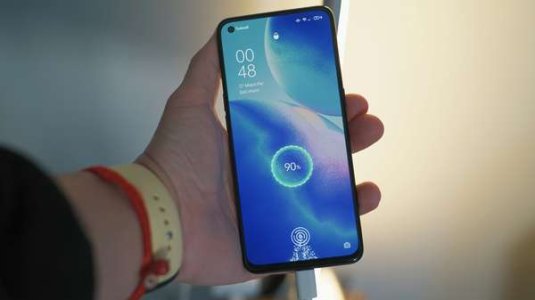Are you destroying your phone battery without realizing it? Here’s what experts say about charging to 100%
- Replies 0
If you’re like most of us here at The GrayVine, you probably plug in your phone at night, let it charge to a satisfying 100%, and wake up ready to tackle the day with a full battery.
After all, who wants to risk running out of juice during a call with the grandkids or while navigating to your favorite lunch spot?
But what if we told you that this well-meaning habit might actually be quietly sabotaging your phone’s battery life?
The Surprising Truth About Charging to 100%
For years, the debate has raged: does charging your phone to 100% really harm the battery, or is it just another tech myth?
According to leading experts in battery technology, there’s more than a grain of truth to the warning.
Chao-Yang Wang, director of the Electrochemical Engine Center at Penn State University, explains that charging your phone all the way to 100% puts the battery under more stress than stopping a bit short.
“A battery will degrade faster if you charge it to 100% versus a little bit lower state of charge,” Wang told the Huffington Post. In other words, topping off to the max every single time can wear your battery out faster.

Dibakar Datta, associate professor of mechanical and industrial engineering at the New Jersey Institute of Technology, adds that keeping your phone at a high voltage (which happens when it’s fully charged) causes it to “chemically age.”
Over time, this means your battery won’t hold a charge as well as it used to.
How Much Damage Are We Talking About?
Before you panic and toss your charger out the window, let’s put things in perspective. Wang estimates that consistently charging to 100% could cause you to lose 10 to 15 percent of your battery’s capacity faster over its lifetime compared to stopping at 90%.
That’s not catastrophic, but it’s enough to notice—especially if you like to keep your devices for several years.
Also read: Stop killing your iPhone battery! The two critical temperatures you need to maintain
The good news? Modern phone batteries are pretty tough. As Wang points out, “You likely will need a new phone for other reasons, such as camera quality or a broken screen, before you need one for battery issues.”
Still, if you want to squeeze every last drop of life out of your phone, it pays to be mindful.
When Is It Okay to Charge to 100%?
Here’s where things get practical. If you know you’re going to have a long, busy day—maybe you’re traveling, or you’ll be out and about with no chance to recharge—go ahead and fill ‘er up to 100%. That extra bit of battery could be a lifesaver.
But if you’re just hanging around the house, or you know you’ll have access to a charger, experts recommend stopping at 85-90%.
Also read: Want a longer battery life? Try these tricks that you never knew existed!
Many newer phones even have settings that let you limit the maximum charge automatically—check your device’s battery settings to see if this feature is available.
The Other Battery Killer: Letting It Run Dry
If charging to 100% isn’t ideal, surely letting your phone run all the way down is better, right? Not so fast. Letting your battery hit 0% can actually be even worse for its long-term health.
Datta recommends plugging in when your battery drops to around 20%. This helps avoid the deep discharges that can make your battery less able to hold a charge over time.
Temperature: The Silent Enemy
If there’s one thing your phone’s battery hates more than being overcharged or drained, it’s extreme temperatures.
Source: BRIGHT SIDE / Youtube.
Both Wang and Datta agree: heat and cold are the real villains. Charging your phone in a hot car or leaving it out in the freezing cold can do more damage than charging to 100% ever could.
Try to keep your phone in a comfortable, room-temperature environment whenever possible.
The Fast-Charging Dilemma
We all love the convenience of fast-charging ports, but they come with a hidden cost. Fast charging generates more heat, which, as we’ve learned, is bad news for your battery.
If you’re not in a rush, use a regular charger and give your phone a little more time to fill up. Your battery will thank you in the long run.
Read next: 5 simple smartphone habits the NSA says can instantly boost your privacy—are you doing them?

Have you noticed your phone’s battery life getting shorter? Do you have any tried-and-true charging habits or tips to share? Maybe you’ve found a clever way to keep your phone cool in the summer heat? Drop your thoughts in the comments below!
After all, who wants to risk running out of juice during a call with the grandkids or while navigating to your favorite lunch spot?
But what if we told you that this well-meaning habit might actually be quietly sabotaging your phone’s battery life?
The Surprising Truth About Charging to 100%
For years, the debate has raged: does charging your phone to 100% really harm the battery, or is it just another tech myth?
According to leading experts in battery technology, there’s more than a grain of truth to the warning.
Chao-Yang Wang, director of the Electrochemical Engine Center at Penn State University, explains that charging your phone all the way to 100% puts the battery under more stress than stopping a bit short.
“A battery will degrade faster if you charge it to 100% versus a little bit lower state of charge,” Wang told the Huffington Post. In other words, topping off to the max every single time can wear your battery out faster.

Experts advise that regularly charging your phone to 100 percent can cause the battery to degrade faster over time, and it’s better to keep it at around 85 to 90 per cent for daily use. Image source: Onur Binay / Unsplash.
Dibakar Datta, associate professor of mechanical and industrial engineering at the New Jersey Institute of Technology, adds that keeping your phone at a high voltage (which happens when it’s fully charged) causes it to “chemically age.”
Over time, this means your battery won’t hold a charge as well as it used to.
How Much Damage Are We Talking About?
Before you panic and toss your charger out the window, let’s put things in perspective. Wang estimates that consistently charging to 100% could cause you to lose 10 to 15 percent of your battery’s capacity faster over its lifetime compared to stopping at 90%.
That’s not catastrophic, but it’s enough to notice—especially if you like to keep your devices for several years.
Also read: Stop killing your iPhone battery! The two critical temperatures you need to maintain
The good news? Modern phone batteries are pretty tough. As Wang points out, “You likely will need a new phone for other reasons, such as camera quality or a broken screen, before you need one for battery issues.”
Still, if you want to squeeze every last drop of life out of your phone, it pays to be mindful.
When Is It Okay to Charge to 100%?
Here’s where things get practical. If you know you’re going to have a long, busy day—maybe you’re traveling, or you’ll be out and about with no chance to recharge—go ahead and fill ‘er up to 100%. That extra bit of battery could be a lifesaver.
But if you’re just hanging around the house, or you know you’ll have access to a charger, experts recommend stopping at 85-90%.
Also read: Want a longer battery life? Try these tricks that you never knew existed!
Many newer phones even have settings that let you limit the maximum charge automatically—check your device’s battery settings to see if this feature is available.
The Other Battery Killer: Letting It Run Dry
If charging to 100% isn’t ideal, surely letting your phone run all the way down is better, right? Not so fast. Letting your battery hit 0% can actually be even worse for its long-term health.
Datta recommends plugging in when your battery drops to around 20%. This helps avoid the deep discharges that can make your battery less able to hold a charge over time.
Temperature: The Silent Enemy
If there’s one thing your phone’s battery hates more than being overcharged or drained, it’s extreme temperatures.
Source: BRIGHT SIDE / Youtube.
Both Wang and Datta agree: heat and cold are the real villains. Charging your phone in a hot car or leaving it out in the freezing cold can do more damage than charging to 100% ever could.
Try to keep your phone in a comfortable, room-temperature environment whenever possible.
The Fast-Charging Dilemma
We all love the convenience of fast-charging ports, but they come with a hidden cost. Fast charging generates more heat, which, as we’ve learned, is bad news for your battery.
If you’re not in a rush, use a regular charger and give your phone a little more time to fill up. Your battery will thank you in the long run.
Read next: 5 simple smartphone habits the NSA says can instantly boost your privacy—are you doing them?
Key Takeaways
- Experts advise that regularly charging your phone to 100 percent can cause the battery to degrade faster over time, and it’s better to keep it at around 85 to 90 per cent for daily use.
- Charging your phone fully is sometimes necessary, especially on days when you need maximum battery life, but doing this constantly can shorten your battery’s lifespan by 10 to 15 per cent.
- Letting your phone battery run completely flat is also harmful, so it’s best to recharge when it drops to about 20 per cent to maintain its health.
- Avoiding extreme hot or cold temperatures and limiting the use of fast-charging ports can further help protect your phone’s battery and prolong its overall performance.
Have you noticed your phone’s battery life getting shorter? Do you have any tried-and-true charging habits or tips to share? Maybe you’ve found a clever way to keep your phone cool in the summer heat? Drop your thoughts in the comments below!






